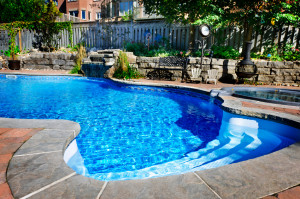If you’re like the many buyers who wait until after going into contract to get insurance quotes on a property, you could be faced with some serious sticker shock. Check out these five seemingly desirable home features that might end up costing you more than you realize in the long run:
1. Swimming pools
 Because of both the high rate of drowning and the severity of water-related injuries, insurance companies consider swimming pools one of their biggest liabilities. Consider the possibility of a neighborhood kid accidentally falling into your pool and sustaining an injury. You could be held liable for the high cost of their hospital bills, and if they choose to sue, you could also rack up considerable lawyer fees and other court expenses.
Because of both the high rate of drowning and the severity of water-related injuries, insurance companies consider swimming pools one of their biggest liabilities. Consider the possibility of a neighborhood kid accidentally falling into your pool and sustaining an injury. You could be held liable for the high cost of their hospital bills, and if they choose to sue, you could also rack up considerable lawyer fees and other court expenses.Most standard homeowners insurance policies include a minimum liability coverage limit of $100,000 in order to help protect you financially in the event of such a lawsuit. However, if your home includes a swimming pool, the Insurance Information Institute recommends increasing your limit to at least $300,000 or even investing in an umbrella policy to increase your liability coverage.
Your insurer will also likely require you to build and maintain a self-locking fence around the pool to keep others – especially children – out. Additionally, if the pool itself is expensive, you may need to increase coverage limits on your policy in the event it’s damaged by a storm or other covered peril.
2. Trampolines
Nearly 100,000 trampoline-related incidents are reported every year, according to a survey by the US Consumer Product Safety Commission’s National Electronic Injury Surveillance System. While the kids may love it, a new trampoline almost certainly won’t play well with your insurance company. Depending on your state and your specific carrier, trampoline-related claims may be excluded from your policy. That means if someone is injured on a trampoline on your property and decides to sue, you might be paying the legal costs out of your own pocket. Even if there are no specific exclusions from your carrier or in your state, it’s still important to notify your agent any time you introduce a “high-risk” item – such as a trampoline, tree house or a swimming pool – to your property to make sure you’ll be properly covered in the event of an accident.
Even if there are no specific exclusions from your carrier or in your state, it’s still important to notify your agent any time you introduce a “high-risk” item – such as a trampoline, tree house or a swimming pool – to your property to make sure you’ll be properly covered in the event of an accident.3. Water view
The value of a waterfront property can be substantially higher than comparable inland properties, whether you live by an ocean, lake, river or some other body of water. However, a beautiful water view often comes with a higher risk for flooding and therefore more extensive insurance coverage.Although most standard homeowners and renters insurance policies include coverage against water damage, they exclude any damage resulting from flood/rising water. For that reason, most residents who live in high-risk flood zones with a water view typically need to invest in separate flood policies in order to protect their properties from the elements. If you have a mortgage on your home, a flood insurance policy will likely be required by your lender. You can check the flood risk of any property by visiting the official site of the National Flood Insurance Program.
4. Vintage charm
Some older homes have maintained original features for decades or even longer, and discovering a well-preserved historical property can be a real estate dream come true. Unfortunately, if key features such as the home’s plumbing system, electrical system or the roof haven’t been updated since poodle skirts were in style, it’s likely an insurance nightmare.If your electrical system hasn’t been updated in more than 10 years, it’s more likely to malfunction and contribute to a damaging fire than one that’s brand new. Similarly, out-of-date plumbing systems could lead to devastating water damage and an older roof is more susceptible to storm damage and other costly damages. With the combined average cost of claims topping $40,000 for these perils, according to the Insurance Information Institute, it’s not surprising insurance carriers charge more to insure these properties.
5. Square footage
Bigger is not always better. The larger your home, the more it will likely cost to replace if it’s ever damaged or destroyed in a covered peril. That means you’ll require a higher amount of dwelling coverage, which is the coverage provided under your homeowners policy to rebuild the structural elements of your home in the event of a claim.To get a rough idea of how much dwelling coverage you’d need to completely rebuild your home from the ground up after a total loss, insurance companies multiply the total square footage of the property by local construction costs. Keep in mind, building with more expensive construction materials will impact your coverage needs, so upgrades such as granite countertops also should be reported to your insurance company.
Of course, none of this should dissuade you from buying a waterfront home or installing a swimming pool. Just be sure you enter into the home buying experience with some knowledge about which types of homes carry higher risk — and therefore larger insurance price tags — than others.


































